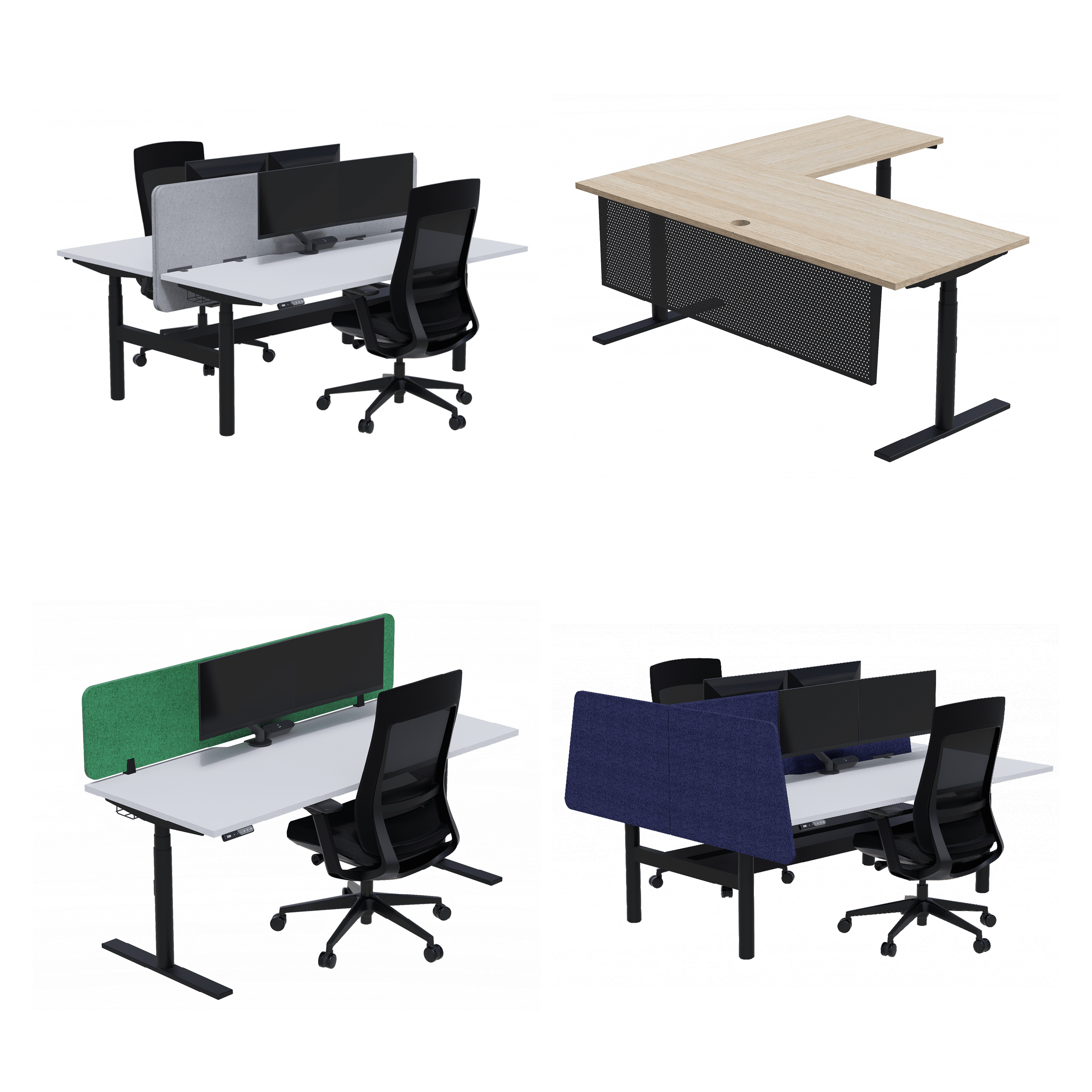Finding the Perfect Office Desk Height: A Guide to Comfort and Productivity
In This Article, You Will Learn:
- Why desk height is important for your comfort, posture, and productivity.
- How to determine your ideal desk height based on your height and ergonomic needs.
- Common issues caused by incorrect desk height, such as back pain and wrist strain.
- Different types of office desks: fixed-height, adjustable, sit-stand, and custom-built options.
- Ergonomic tips for setting up your desk, including the right chair position, monitor height, and keyboard setup.
- How to optimise your workspace for maximum comfort and efficiency, with suggestions like using footrests and proper lighting.
- The benefits of a tailored workspace and why investing in ergonomic furniture can improve your overall well-being and work performance.
Why Office Desk Height Matters
The height of your office desks plays a crucial role in your overall comfort, posture, and productivity. A poorly adjusted desk can lead to back pain, neck strain, and even long-term musculoskeletal issues. Understanding the ideal desk height ensures that you can work efficiently while maintaining good health.
This guide explores everything you need to know about office table height, including standard measurements, ergonomic considerations, historical context, and how to choose the best desk height for your needs.
The Standard Office Desk Height
What Is the Average Desk Height?
Most professional desks are designed with a standard height of 73 to 76 cm (28 to 30 inches). This measurement is suitable for the average adult, but it may not be ideal for everyone.
Why the Standard Height Exists
The standard desk height was developed based on:
- Traditional woodworking standards – Early office furniture makers established this range based on the average user.
- Corporate design preferences – Many companies adopted a one-size-fits-all approach to streamline office furniture production.
- Compatibility with standard office chairs – Most office chairs are designed to match these desk heights, reducing the need for customisation.
However, as work habits evolve and ergonomic awareness increases, businesses and individuals are shifting toward adjustable and customised desk heights.
How to Determine Your Ideal Desk Height

1. Consider Your Height
The most effective way to determine the best desk height is by considering your own height:
- Under 160 cm (5’3” and below): Ideal desk height: 65-70 cm
- 160-175 cm (5’3” – 5’9”): Ideal desk height: 71-75 cm
- 176-190 cm (5’10” – 6’3”): Ideal desk height: 76-80 cm
- Above 190 cm (6’3” and above): Consider a taller or adjustable desk.
2. Maintain a Neutral Posture
When seated at your desk:
- Your elbows should be at a 90-degree angle while typing.
- Your feet should be flat on the floor (or on a footrest if needed).
- Your wrists should remain in a neutral position without excessive bending.
- Your computer monitor should be at eye level to prevent neck strain.
3. Use an Adjustable Chair or Desk
For flexibility, consider:
- Adjustable desks – These allow you to set the perfect height and even switch between sitting and standing positions.
- Ergonomic chairs – A chair with an adjustable seat height can help compensate for an unsuitable desk height.
The Impact of Poor Desk Height
If Your Desk Is Too High
- Shoulder tension – Raised arms can cause strain and discomfort.
- Wrist pain – Increased pressure on wrists may lead to repetitive strain injuries (RSI).
- Neck and upper back strain – Looking up at your monitor leads to posture problems.
If Your Desk Is Too Low
- Slouching – Leads to back pain and poor spinal alignment.
- Knee discomfort – Your legs may feel cramped under a desk that’s too low.
- Reduced productivity – Uncomfortable positioning decreases focus and efficiency.
The Evolution of Office Table Design
Historically, office tables were built for function over comfort. Early desks were crafted from wood and were often bulky and fixed in height. As office environments modernised, adjustable furniture became popular, allowing for more ergonomic setups.
Key Milestones in Desk Design:
- 19th Century: Large wooden desks for writing and storage.
- 20th Century: Standardised desk heights with metal frames.
- 21st Century: Ergonomic and height-adjustable desks, including sit-stand options.
Today, many offices prioritise ergonomic workstations that adapt to individual needs, improving both health and efficiency.
How to Adjust Your Desk for Maximum Comfort
Spending hours at your desk can take a toll on your body, but a well-adjusted workspace can make a world of difference. Small changes can improve posture, reduce strain, and help you feel more comfortable throughout the day. Here’s how you can fine-tune your setup for a better working experience.
1. Find the Right Chair Position
A good chair supports your back and encourages healthy posture. Start by making sure your feet rest flat on the floor—this helps distribute your weight evenly and prevents unnecessary strain on your lower back. Your knees should form a 90-degree angle, keeping your legs comfortable and preventing circulation issues. If your chair has armrests, adjust them so your elbows rest naturally at desk height without raising your shoulders or causing tension.
2. Use a Footrest If Needed
If your feet don’t comfortably reach the floor, a footrest can provide the support you need. This helps maintain proper leg positioning, reducing strain on your lower back and improving circulation. A sturdy box or a small stool can work just as well if you don’t have a dedicated footrest.
3. Position Your Monitor for Better Posture
Your screen’s placement plays a big role in preventing neck and eye strain. Ideally, the top of your monitor should be at or just below eye level, so you’re not tilting your head up or down. Keeping the screen at arm’s length prevents unnecessary eye fatigue. If you use multiple screens, arrange them in a way that minimizes excessive head movement.
4. Consider a Standing Desk
Sitting for long periods can lead to stiffness and discomfort. A sit-stand desk allows you to alternate between sitting and standing throughout the day, keeping your body engaged and reducing the risks associated with prolonged sitting. If a standing desk isn’t an option, make it a habit to stand and stretch regularly to keep your circulation flowing.
5. Keep Your Keyboard and Mouse at a Comfortable Height
Your keyboard and mouse should be positioned so your arms remain relaxed, with your wrists in a neutral position. Avoid placing them too high or too low, as this can lead to discomfort in your shoulders and wrists over time. If needed, use a wrist rest to keep your hands in a natural position.
6. Adjust Your Desk Layout for Efficiency
Keeping frequently used items within easy reach reduces unnecessary stretching and straining. Place your phone, notepad, and other essentials close by so you can access them without twisting or overextending your arms. A clutter-free workspace not only looks better but also helps you stay focused.
7. Pay Attention to Lighting
Poor lighting can cause eye strain and headaches. Position your desk near natural light if possible, but be mindful of glare on your screen. If overhead lighting is too harsh, a desk lamp with adjustable brightness can help create a more comfortable environment.
Making these simple adjustments can significantly improve your workday. By setting up your desk with comfort in mind, you’ll reduce strain, stay more focused, and feel better at the end of the day.
How to Choose the Right Office Desk

Selecting an office desk goes beyond just picking something that fits your space—it’s about finding a setup that supports your body and work habits. The right desk can make all the difference in preventing discomfort and maintaining efficiency throughout the day. Here’s a closer look at different desk options to help you decide what works best for you.
1. Fixed-Height Desks
A traditional option, fixed-height desks are designed for individuals whose height aligns with the standard range. While they provide a sturdy and reliable workspace, they may not suit everyone’s ergonomic needs. If you find that your desk is too high or too low, accessories like footrests or monitor stands can help improve comfort and posture.
2. Adjustable Desks
Great for shared workspaces or individuals who prefer flexibility, adjustable desks allow you to modify the height to suit different users. This feature ensures a more personalized setup, making it easier to maintain proper posture and reduce strain on the body. Whether you prefer to sit or stand, having control over your desk height can make a significant impact on comfort.
3. Sit-Stand Desks
Designed to support a balance between sitting and standing, sit-stand desks encourage movement throughout the day. Prolonged sitting can lead to stiffness and discomfort, but alternating between positions helps reduce strain on your back and improves circulation. These desks are ideal for those looking to stay more active while working without disrupting productivity.
4. Custom-Built Desks
For those with specific ergonomic needs, custom-built desks offer a tailored solution. Whether you require a unique height, special materials, or integrated accessories, these desks are designed to match your exact preferences. While they may come at a higher cost, the investment in comfort and efficiency can be well worth it for those who spend long hours at their desks.
Finding the right desk is all about understanding what works best for your body and workflow. By considering your daily habits and comfort needs, you can create a workspace that supports both productivity and well-being.
Final Tips for a Healthier Workspace
- Invest in an ergonomic chair that supports proper posture.
- Take regular breaks to stretch and move around.
- Maintain a clean workspace to enhance focus and efficiency.
- Use proper lighting to reduce eye strain and headaches.
Find the Perfect Office Desk with Aurora Office Furniture
Choosing the right office desk height is essential for comfort, productivity, and long-term health. At Aurora Office Furniture, we offer a wide range of ergonomic desks, including adjustable and sit-stand desks designed to fit your needs.
Explore our collection today and transform your workspace into a haven of comfort and efficiency!








